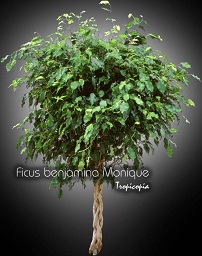Table of contents
Weeping fig

Latin Name: Ficus benjamina Monique
Category: Ficus
Family: Moraceae
Origin: Cultivar
Climate: Tropical
Growing Zones: 11-9
Care Instructions
The Weeping fig (Ficus benjamina Monique) is a tropical plant that originates from Cultivar. This ficus plant belongs to the Moraceae family and is well-suited for growing in USDA zones 11-9.
Complete Care Guide for Weeping Fig (Ficus benjamina Monique)
Watering Requirements
The Weeping Fig, or Ficus benjamina Monique, thrives best with a consistent watering schedule. It is essential to allow the top inch of soil to dry out between waterings. Overwatering can lead to root rot, a common issue with this species. During the growing season (spring and summer), water the plant thoroughly, ensuring that excess water drains out of the pot. In the fall and winter, reduce watering frequency as the plant enters a dormant phase. Always check the moisture level by inserting your finger into the soil; if it feels dry, it’s time to water. Additionally, using room temperature water can help prevent shock to the roots.
Light Conditions
The Weeping Fig prefers bright, indirect light for optimal growth. While it can tolerate lower light conditions, insufficient light may lead to leggy growth and leaf drop. Ideally, place your Ficus benjamina Monique near a window that receives filtered sunlight. If you notice the leaves turning yellow or dropping, it may be a sign that the plant is not receiving enough light. Conversely, direct sunlight can scorch the leaves, so it’s crucial to find a balance. If you’re growing it indoors, rotating the plant every few weeks can help ensure even growth and prevent it from leaning towards the light source.
Soil Preferences
The ideal soil for a Weeping Fig is a well-draining potting mix that retains some moisture without becoming waterlogged. A mixture of peat moss, perlite, and pine bark works well to provide the necessary drainage and aeration. It’s important to repot the plant every couple of years to refresh the soil and provide more space for growth. When fertilizing, use a balanced liquid fertilizer every four to six weeks during the growing season. This will promote healthy foliage and overall growth. Be cautious not to over-fertilize, as this can lead to salt buildup in the soil, which can harm the roots.
Pests and Diseases
Common pests that may affect the Weeping Fig include spider mites, aphids, and scale insects. Regularly inspect the leaves for any signs of infestation, such as webbing or sticky residue. If you notice pests, treat the plant with insecticidal soap or neem oil, ensuring to cover both the tops and undersides of the leaves. Additionally, the Weeping Fig can be susceptible to fungal diseases, particularly if overwatered. Signs of disease include yellowing leaves and a mushy stem. To prevent these issues, maintain proper watering practices and ensure good air circulation around the plant.
Special Care Tips
To keep your Weeping Fig healthy and thriving, consider the following special care tips: First, avoid sudden changes in temperature or humidity, as this can stress the plant and lead to leaf drop. Ficus benjamina Monique enjoys a humid environment, so misting the leaves or placing a humidity tray nearby can be beneficial, especially in dry indoor conditions. Additionally, dust can accumulate on the leaves, hindering photosynthesis; gently wipe the leaves with a damp cloth to keep them clean. Lastly, be patient with your plant; Ficus benjamina can be sensitive to changes in its environment, and it may take time to adjust to new conditions.








